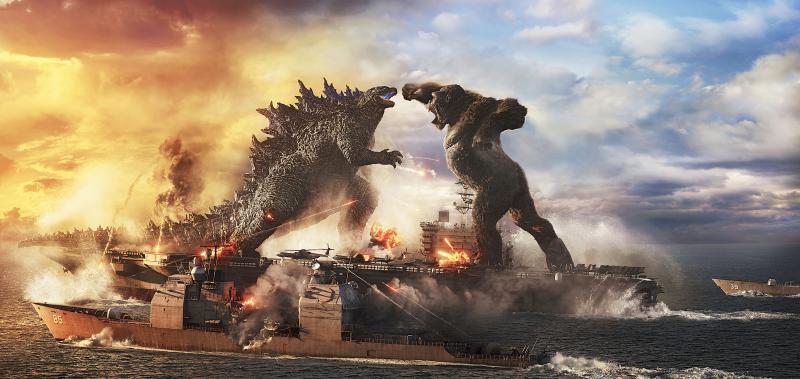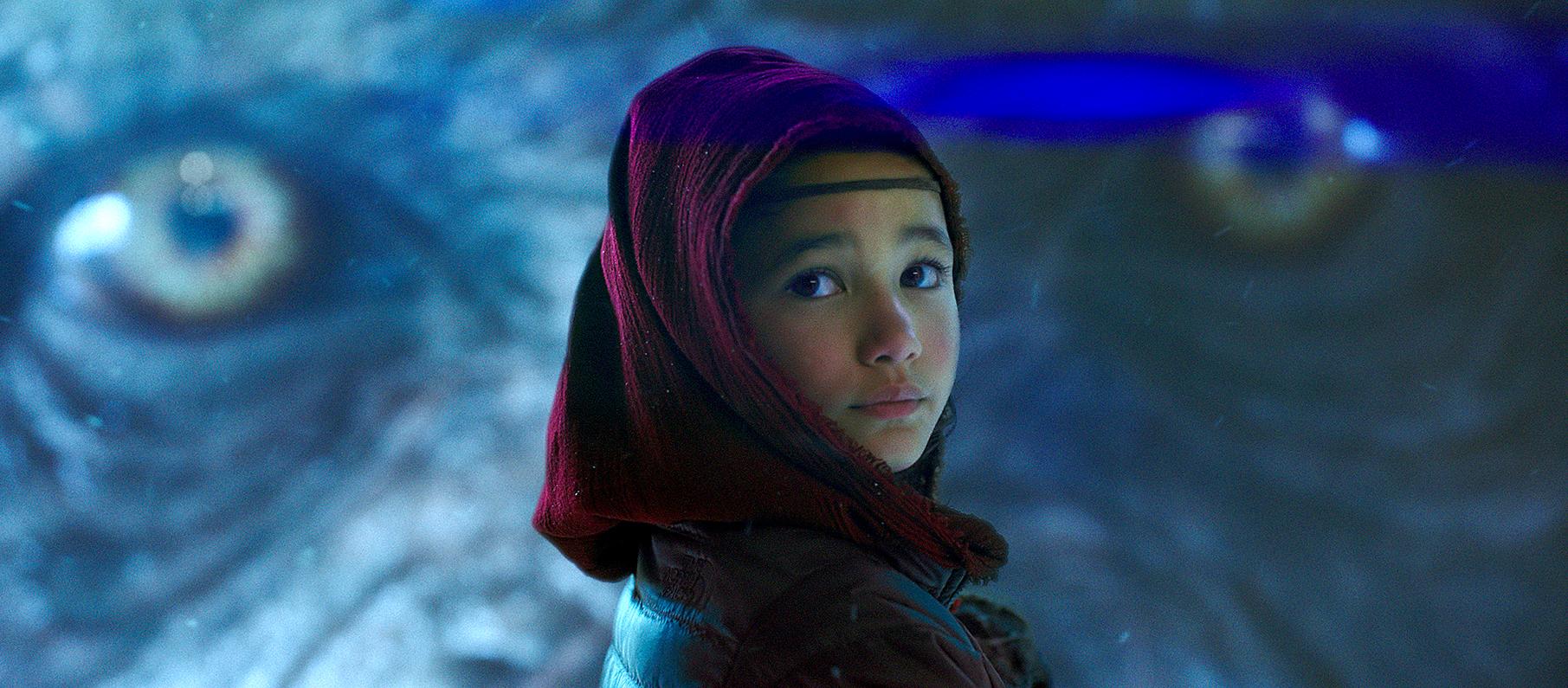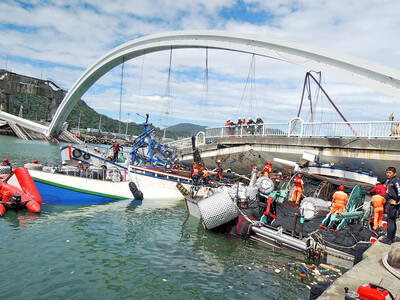Godzilla vs Kong begins, fittingly, with the big guy asleep.
There is King Kong, colossus of the big screen, slowly waking on a mountainside. He rouses slowly in the morning sun from slumber before showering in a nearby waterfall. It’s, maybe, a little bit the same for the kind of movies King Kong symbolizes and still holds some dominion over: big spectacles of mass destruction made to be seen on equally towering screens. That kind of moviegoing has been been in hibernation for much of the past pandemic year.
Godzilla vs Kong, the only creature feature to dare wide release in some time, is a rock ‘em-sock ‘em monster-movie revival with all the requisite explosions, inane plot twists and skyscraper smashing to satisfy most lovers of gigantic amphibians. Vive le cinema!

Photo: Warner Bros Entertainment via AP
Godzilla vs Kong, directed by Adam Wingard, follows in the very big but quickly forgotten footsteps of the 2014 reboot Godzilla, 2017’s Vietnam-set, Apocalypse Now-tinged sequel Kong: Skull Island and 2019’s Godzilla: King of Monsters.
But, of course, the lineage is much longer than that. Godzilla and Kong first squared off in 1962’s King Kong vs Godzilla (Kong got first billing back then), the Toho Studios film that mashed together monsters both East and West. (Before the Japanese studio got involved, the original template had Kong meeting Frankenstein.)
This time, the ultra-heavyweight prize fight between the Coke and Pepsi of the MonsterVerse doesn’t break any new ground. That might be its salvation. Wingard (You’re Next, The Guest) gives us some solid supporting characters (Brian Tyree Henry as a podcasting conspiracy theorist on the right track is the best of the humans) and some slick sound design. But mostly Godzilla vs Kong supplies appropriately silly sci-fi escapades and a few good rounds of monster mayhem, including, in their first meeting, a ballet of battleships on the open ocean.

Photo: Warner Bros Entertainment via AP
One difference this go around: You can see the film immediately on either a Godzilla-sized screen or a salamander-sized one. Godzilla vs Kong is playing in theaters and streaming simultaneously on HBO Max. I saw it at home, with a five-year-old in the next room asking why the big monkey was so angry.
For the mighty Empire State Building-climbing beast, it’s a new, more humble home. And it’s home he seeks in Godzilla vs Kong. That sunny morning waterfall, it turns out, is an enclosed habitat for the locked-up ape, who’s watched over tenderly by Dr Ilene Andrews (Rebecca Hall) and her deaf adopted daughter Jia (Kaylee Hottle).
When Godzilla makes a seemingly unprompted attack on Apex, a high-tech cybernetics company ruled by Walter Simmons (Demian Bichir), a plan is hatched to use Kong to lure Godzilla to the surface and then track Godzilla to his power source — an undiscovered center-of-the-world realm theorized to exist by “hollow Earth” proponent Nathan Lind (Alexander Skarsgard).
It’s a scheme so obviously destined to run afoul and turn a metropolis into ruins that you can almost hear Hong Kong pleading, “Please, no.” With a debt owed to Jules Verne, Godzilla vs Kong makes its way, via Antarctica, to the center of the Earth. It covers a lot of mileage only to ultimately fall back where so many action blockbusters do: at the hands of a melomaniac tech CEO.
It’s not just a predictable foe for the kaijus, who have cycled through countless metaphors over the decades. It’s also a somewhat ironic one. Godzilla vs Kong is so much a totem to the powers of advanced technical wizardry. Shot with a lustrous glow by Ben Seresin, the movie is soaked in the glossy sheen of CGI. King Kong, born in stop-motion, and Godzilla, once a guy in a suit, have swelled so much in design and texture that they now appear like veteran movie stars who have moved on from their B-movie origins.
By they end, they appear exhausted, and who can blame them? They’re likely tired from emerging again and again from the depths to play out our fantasies of destruction. Next time, someone should let Kong hit the snooze.

Before the recall election drowned out other news, CNN last month became the latest in a long line of media organs to report on abuses of migrant workers in Taiwan’s fishing fleet. After a brief flare of interest, the news media moved on. The migrant worker issues, however, did not. CNN’s stinging title, “Taiwan is held up as a bastion of liberal values. But migrant workers report abuse, injury and death in its fishing industry,” was widely quoted, including by the Fisheries Agency in its response. It obviously hurt. The Fisheries Agency was not slow to convey a classic government

Not long into Mistress Dispeller, a quietly jaw-dropping new documentary from director Elizabeth Lo, the film’s eponymous character lays out her thesis for ridding marriages of troublesome extra lovers. “When someone becomes a mistress,” she says, “it’s because they feel they don’t deserve complete love. She’s the one who needs our help the most.” Wang Zhenxi, a mistress dispeller based in north-central China’s Henan province, is one of a growing number of self-styled professionals who earn a living by intervening in people’s marriages — to “dispel” them of intruders. “I was looking for a love story set in China,” says Lo,

It was on his honeymoon in Kuala Lumpur, looking out of his hotel window at the silvery points of the world’s tallest twin skyscrapers, that Frank decided it was time to become taller. He had recently confessed to his new wife how much his height had bothered him since he was a teenager. As a man dedicated to self-improvement, Frank wanted to take action. He picked up the phone, called a clinic in Turkey that specializes in leg lengthening surgery — and made a booking. “I had a lot of second thoughts — at the end of the day, someone’s going

In the next few months tough decisions will need to be made by the Taiwan People’s Party (TPP) and their pan-blue allies in the Chinese Nationalist Party (KMT). It will reveal just how real their alliance is with actual power at stake. Party founder Ko Wen-je (柯文哲) faced these tough questions, which we explored in part one of this series, “Ko Wen-je, the KMT’s prickly ally,” (Aug. 16, page 12). Ko was open to cooperation, but on his terms. He openly fretted about being “swallowed up” by the KMT, and was keenly aware of the experience of the People’s First Party